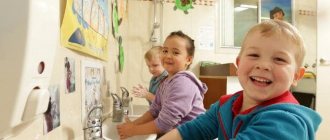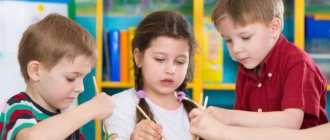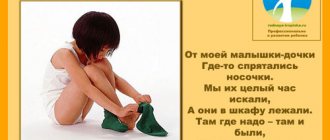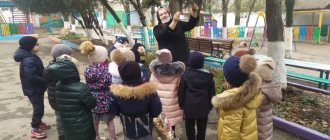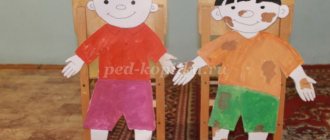Formation of a nutrition culture among preschool children. Abstract of OOD in the senior group with presentation
Formation of a nutrition culture among preschool children
Slide 1 Formation of a nutrition culture in preschoolers Slide 2 Formation of a nutrition culture in preschoolers can be implemented through three main directions: 1. Formation of ideas about: • the importance of proper nutrition for the functioning of the whole body and individual internal organs.
• the role of nutrients for the normal functioning and development of every living organism. • usefulness of various products and dishes. 2. Fostering a culture of behavior at the table. 3. Compliance with hygienic requirements Work on developing a nutritional culture should be carried out taking into account the age characteristics of children. In our preschool educational institution for all age groups, a long-term work plan has been drawn up “Formation of a nutrition culture for children”, which allows in an accessible form to form practical skills and principles of proper nutrition, as well as cultivate a culture of behavior at the table and comply with hygienic requirements. Slide 3 The teacher’s work system involves the use of various forms and methods of organizing food culture. The main form of work is direct educational activities, games, leisure, and entertainment. Slide 4. The assigned tasks are implemented through free play activities and special educational games, educational games, entertainment, quizzes, etc. In preschool educational institutions, educational activities are systematically conducted on the topics of educating children about food culture: children learn to set the table correctly and beautifully, sit correctly at the table, and use cutlery and utensils. This is reinforced with the help of didactic, board and role-playing games, created special situations, as well as in classes on speech development, artistic activities, etc. Slide 5 In organizing children's activities, much attention is paid to game techniques. Heroes of famous fairy tales, short stories, and cartoons come to visit the children - Piggy, Stepashka, Aibolit, dolls Healthy, Nehochukha, etc. These characters turn to the children for help or ask them to teach them something they don’t know or can’t do. Game exercises are associated with the child’s compliance with certain rules of healthy eating. Slide 6. Culinary and sensory games are widely used in practice: “prepare a vegetable or fruit salad”, “cook compote”, “guess by taste”, “guess by smell”. These games introduce children to the process of preparing dishes, help evaluate the usefulness of the product, and arouse taste interest in the dishes. Entertaining competitions were held: “The Most Common Porridge”, “Vitaminka”, where children were asked to decorate their dish with fruits and vegetables, and also a competition “Connoisseurs of Vegetables and Fruits” was held, where children not only described the appearance, but also the taste of the product. Slide 7, 8, 9, 10, 11, 12, With the help of the developed presentation “Vitamins grow on a branch, vitamins grow on a garden bed,” children easily and with interest became acquainted with the concept of “vitamins”; consolidated knowledge about the need for vitamins in the human body, about healthy products that contain vitamins. A “healthy products” campaign was organized and passed with interest, where children, together with their parents, advertised healthy and important products and made colorful sketches and albums with recipes. An important method in forming the foundations of a food culture is reading fiction, which helps enrich children’s vocabulary, introduce them to folklore, teaches children to be polite, hospitable, cultivates a culture of behavior at the table and develops cultural and hygienic skills, and develops their horizons. Slide 13. The group systematically updates the demonstration stand, “What is good and what is bad,” which the children create together with the teacher. For example, when making various stickers about food products, children all together select and classify what benefits their body and what can be harmful. Slide 14. Classes and conversations about food culture have been developed and are systematically conducted with children. Slide 15. A survey conducted among parents “On the proper nutrition of children” showed that many adults do not have sufficient knowledge in the field of nutrition culture. Slide 16. Some people do not have the slightest idea about dietary and child nutrition, so one of the most important tasks of preschool educational institutions is effective interaction with parents on the topic “Nutrition culture and its importance for human health.” Slide 17. The forms of working with parents are quite diverse. Sample topics for parent meetings: “Healthy nutrition for patients with allergies”; “Vitamins in your child’s diet”; “Organization of (proper) nutrition for future schoolchildren”, “Nutrition and education”, “Formula of proper nutrition”, “Weekend menu”, etc. Slide 18. Let's talk about product compatibility The results of an unbalanced diet are visible to the naked eye: the child has a tendency to allergies , he catches colds too often, he almost always has a poor appetite... • Remember that kefir and cottage cheese go well with fruit. • Meat and fish are best served with vegetables. Cereals are also suitable as a side dish. • But pasta with meat is an unbearable combination for the stomach of a small child. • Also keep in mind that you cannot combine different types of protein—eating fish, meat, and mushrooms at the same time. • Fruits are compatible with almost all products. Just don’t offer your baby sweet grapes immediately after a hearty meat lunch: his stomach has no time for sugar right now. • Speaking of sugar: sweets are only appropriate as a snack between main meals. Moreover, at least two hours should pass between eating dates and soup. • Don't forget about drinks: let your child drink sweet compote or juice only 20 minutes after eating. Slide 19. Cultural and hygienic habits of eating in children. The professional duty of a kindergarten teacher is to teach the child table manners. This learning occurs both in specially organized classes and during meals. Proper and beautiful table setting increases appetite and creates a friendly mood among others. The ability to behave at the table, use cutlery and napkins develops self-confidence in children. During the meal, the teacher explains and explains to them the beauty of etiquette, the rationality and the need to observe it during the feast. Closer relationships arise between people eating: the child perceives the teacher as part of a family community, trusts him and listens to his words. The kindergarten teacher is guided by the tasks formulated in the programs. Let us trace the sequence and graduality of tasks for the formation of cultural and hygienic skills, taking into account the age characteristics of the child. Slide 20. First junior group (from 2 to 3 years old) • Strengthen the ability to wash your hands independently before eating, wipe your face and hands dry with a towel, eat neatly, chew food thoroughly, hold a spoon in your right hand, use a napkin, rinse your mouth when prompted by an adult . • Develop the ability to follow the basic rules of cultural behavior: do not leave the table without finishing the meal, say “thank you” • In pictures and in life, recognize and correctly name the processes of eating, know the objects necessary for food, their properties and qualities; • Experience positive feelings in connection with performing hygienic actions; • Know short poems or nursery rhymes about food, repeat them after an adult or independently Slide 21. Second junior group (from 3 to 4 years old) • Teach how to independently and carefully wash your hands and face, use soap and a comb correctly, wipe dry after washing, hang towel in its place • Develop eating skills: do not crumble bread, use cutlery and napkins correctly, chew food with your mouth closed • In life and in pictures, confidently recognize and name the processes of eating • Know many objects and actions associated with performing hygienic processes when when eating • Know certain rules of behavior at the table (do not talk until you have chewed and swallowed food, behave calmly, do not crumble bread, thank your elders) • Know poems about eating, enjoy listening to children’s books read and look at pictures with relevant content . Slide 22. Middle group (from 4 to 5 years old) • Improve acquired skills: take food little by little, chew well, eat quietly, use cutlery correctly (spoon, fork, knife), napkin, rinse your mouth after eating • Develop a positive attitude towards hygiene processes and food culture. Understanding that others approve of actions related to compliance with the rules of hygiene and neatness, and condemn manifestations of sloppiness and untidy food • Know by heart poems, nursery rhymes related to the implementation of cultural and hygienic rules. Slide 23. Senior group (from 5 to 6 years old) • Strengthen the ability to correctly use cutlery (fork, knife); eat carefully, silently, maintaining correct posture at the table • Continue to instill the skills of a culture of behavior: when leaving the table, quietly push your chair in, thank adults. Slide 24. Preparatory group for school (from up to 7 years old) • Strengthen table behavior skills: sit straight, do not put your elbows on the table, drink and chew food quietly, use a knife, fork, and napkin correctly. Slide 25. Table setting in a preschool educational institution The psychological comfort of children during their stay in an educational institution largely depends on the organization of food. An important point in the proper organization of meals is good serving; it plays a big role in the development of the child’s appetite. The dishes should be small in size, and most importantly attractive: with an elegant design and beautiful shape. Forks should be given to children starting from the younger group. Children 5-6 years old need to be taught to use both a fork and a knife, but they must be of the appropriate size... For younger children, ordinary children's deep plates are convenient; for children 5-6 years old it is better to have a medium size (300-400 g). It is good to have small plates of two sizes: dessert - for breakfast and afternoon tea, and small, corresponding to the size of deep plates, - for main courses. The shape of the cups is more convenient: straight or narrowed at the top, and not vice versa; such cups are more stable. Dessert tablespoons are convenient for children, but regular ones can be given to older children. You also need teaspoons for compote, cottage cheese and other dishes. For each group, it is desirable, if possible, to have its own dishes, different in design from the dishes of the other group. Children are very pleased when, after moving to another group, they see a different design on their cup and plate. Good table settings go a long way in improving children's appetite and strengthening cultural skills. The attendants take an active part in preparing tables for meals. Slide 26. Duties are introduced in the second junior group at the end of the year; they set only one condition for the child: to help the junior teacher set the table only for those children who are sitting with him. The child hands out spoons, puts out bread bins, glasses with napkins. The understanding of responsibility is not yet available to children of four years old, and it would be wrong to put such a requirement before them. In guiding children, the teacher relies on their interest in the process of activity, creates an emotionally positive attitude towards it, explains the need to work hard and in every possible way encourages any attempt by the child to show independence. He forms in children an idea of the importance of the work of those on duty, of the priority in carrying out the assigned work: “Today Seryozha will take care of his comrades, he will be on duty at this table. And Nastya will set one table, Dima will set the other. Everyone immediately feels uncomfortable working. Let them work hard for everyone today, and let the other children who sit next to them tomorrow. So, everyone will take turns helping the nanny.” In the middle group, if duty is organized for the first time, the teacher uses the same techniques at the beginning of the year (September - October). As at a younger age, in order to find out how much children have mastered their skills, let them get used to the living conditions in the group. In the second half of the year, when children's skills become stronger, you can increase the amount of their work. For example, the attendants can be instructed to arrange the saucers placed on the table by the nanny and carry two cups from the serving table to the children's tables. The attendants themselves fill the glasses with napkins. Children clear the dishes after eating: each child places his plate on top of another, asking the other to lift the spoon. When leaving the table, he can take his cup and take it to the serving table. The attendants clear the bread bins and glasses with napkins from the table, and the nanny clears the folded plates. Duties in the senior and school-preparatory groups of kindergarten gradually become more complicated in terms of the content of work, and in the forms of unification of children, and in terms of the requirement for independence in the process of work, and in self-organization in the process of activity. The shift of duty personnel is carried out daily. The work of the dining room attendants includes full table setting and cleaning after meals. When organizing the work of those on duty, the teacher has to pay attention to one more issue - the combination of the work of those on duty with the self-service of children. For example, after eating, should those on duty clean everything up, or does everyone clean up after themselves? The most appropriate arrangement would be to organize cleaning in a way that naturally combines the work of the attendants and each child. For example, after eating, each child moves his plate to the middle of the table, stacking it on top of others, and takes the cup and saucer to the serving table. (At the same time, it is important to ensure that children do not linger near the serving table and do not create a mess there. This will not happen if the children are comfortable and are accustomed to folding dishes neatly.) Slide 27. A child’s appetite largely depends on how food is served , its appearance is so attractive. Here are examples of how important it is for food to have an attractive appearance. Previously, the junior teacher would put croutons on plates and pour hot broth over them; By the time the children sat down at the table, the croutons became soggy and the dish looked unappetizing. We suggested serving croutons separately, and the children began to eat the soup with croutons with pleasure. Another example: when giving the children buckwheat porridge and milk, the junior teacher put the porridge into deep plates and poured milk on top. Some children ate reluctantly or refused to eat at all. Then we offered these children porridge and milk separately, and they willingly ate everything. Since then, we began to give the children porridge separately in a deep plate and milk next to it in a cup, and the children eat as they want. We teach children to eat from the side of the spoon, not to fill the spoon, not to pull soup from the spoon, not to lick it. The last rule is especially important when eating second and third courses. We explain to the children that they cannot blow into a spoon or into a plate, because the splashes may fall on the tablecloth or on a neighbor. We teach dishes such as meat and fish cutlets, fried or boiled fish, potato cutlets, cottage cheese, scrambled eggs, scrambled eggs, various casseroles to separate one piece at a time with the edge of a fork and eat it by picking it up on the fork, rather than cutting the entire portion received at once. Only children who cannot cope with it themselves have to cut the portion completely. We teach children to eat cutlet, meat, fish at the same time as a side dish: a piece of cutlet, meat or fish and a lot of side dish. If children are not taught to eat meat, fish and other dishes with a side dish, they mostly eat the side dish first, and then the cutlet or fish. We place pies, cheesecakes, cookies, gingerbreads in the middle of each table in common plates or bread bins. We teach children to take, without choosing, the pie or cookie that lies closest to them. We have to teach children to drink milk, tea, coffee or other drinks with sandwiches, pie, cookies in small sips so that they finish drinking and eating at the same time. If they are not taught this, then they first drink the liquid, and then eat dry what is given to it, and, of course, eat with difficulty. One of the conditions necessary to create a favorable environment during meals is the correct behavior of adults and children during meals. Adults (teacher and junior teacher) talk to each other in a calm, quiet voice only about matters related to feeding children. There should be no conversations with each other. You should not make comments to all children at once. You should not rush children with words: “eat quickly”, “finish your food quickly”, it is better to serve food in a timely manner and thereby ensure that children do not linger at the table. Gradually, the pupils get used to eating culturally. Slide 28. How to behave at the table. • Don't sit slouched.
• Don't cross your legs. • Don't shuffle your feet, don't talk. • Don't turn around, don't push your friend. • Eat carefully, do not spill on the tablecloth. • Bite the bread over your plate. • Do not bite off large pieces of bread at once. Eat quietly. Don't slurp. • Hold your fork, spoon and knife correctly. • When drinking, the cup should be raised towards the mouth, and not arched towards the cup when it is on the table. • After eating, put your spoon and fork on your plate. • When leaving the table, remove your chair and say thank you. • Rinse your mouth after eating. During breakfast and lunch, we allow children to calmly make a request to the teacher; To advise a comrade to take a crust - “help”, and not touch the food with his fingers, remind the comrade himself if he holds the spoon incorrectly, and not scream: “Vova holds the spoon incorrectly!” We do not allow other conversations during food. Slide 29. Classes on the topic “Tining etiquette” 1. “Dishes and cutlery” 2. “How to properly and beautifully cover on the table” 3. “behavior at the table” 4. “Tea of friends” 5. We will teach Masha the table for dinner Slide 30. Summary: "We will teach Masha the table setting for dinner."
Program content: - Activate the vocabulary on the topic, expand the vocabulary of adjectives;
— Develop children’s coherent speech, consolidate the ability to give a complete answer to the question posed; — Consolidate knowledge about different types of utensils and their purposes; — Develop: finger motor skills, memory, perception, memory, thinking; — Develop the ability to properly handle utensils; — To develop the skill of consistency in setting the table for dinner and clearing dishes after eating, — To develop the ability to properly set the table for dinner. Slide 31. Preliminary work: - Examination of dishes during meals; — Guessing and learning riddles about dishes; — Games: “What’s in what” (word formation), “On the contrary” (selection of antonym words), “What dishes are hidden?” etc. - Reading fairy tales by K. Chukovsky “The Tsokotukha Fly”, “Fedorino’s Grief”, the Russian folk tale “The Fox and the Jug” Slide 32. Equipment: tablecloth, napkins, cutlery (spoons, forks, knife), dining room, presentation “Scullion” dishes (deep plate, shallow plate, cup, saucer, bread box), napkin holder, cloth napkins for table setting. Methods and techniques: surprise moment, asking riddles, didactic games: “The fourth odd one”, “Clear the table” Vocabulary work: serving, cutlery. Slide 33. Course of the lesson: The children, together with the teacher, enter the group, where the offended Masha is already sitting and the bear Mishka is standing next to him. - Guys, we have guests. Hello, Masha and Mishka. What's happened? Why did you quarrel? -We wanted to have lunch and I decided to help Mishka set the table, but he didn’t like the way I did it. -Let's see why Mishka didn't like it. (the teacher pays attention to the table). - Guys, look, has Masha set the table for dinner correctly? (Answer). - Bear, don’t be upset, we’ll teach Masha how to set the table correctly. Our children do this every day. In ancient times, people did not think about how to eat the food they caught. His own hands were enough for him; before, cutlery did not exist. Time passed, people changed, concepts about food changed, varieties of dishes expanded, and this required their appearance. In the countries of East Asia, they began to use chopsticks made of bamboo or bone for eating; in countries with a European lifestyle, other cutlery - spoon, fork, knife, plate. Following were the rules for using these devices. Rules appeared that told how to correctly lay out and place dishes on the table, which began to be called “table setting.” Our children already know these rules and will teach them to Masha. -Masha, listen to the poem “What are dishes for?” If there were no dishes, We would have had a very bad time.
We would immediately turn from people into savages: We would take the meat with our hands, We would gnaw it with our teeth, We would drink water in the river Or in a dirty stream. Fortunately, various utensils help us everywhere: They put food on it, they eat and drink from it. Food is stored in it: Cheese and butter, bread and fruit... Hundreds of dishes are prepared in it - boiled, fried and baked. -Now, Masha, the guys will show you how to properly set the table for dinner. 1 child - Lay out a tablecloth and place napkins on top of it for each child so that the table remains clean. (children perform actions as needed). Child 2 – Place a napkin holder with napkins for the mouth and hands on the table. Child 3 – Place a bread saucer or bread box on a napkin in the center. 4 child - Place small saucers around the saucer or bread box: the handles of the cups point to the right, on them are teaspoons for compote; if there is dried fruit in the compote, put a teaspoon on the saucer to eat them. Slide 34. Teacher - Masha, guess the riddle: It is necessary for us, After all, we eat food from it. Deep and shallow. Her name is .... (plate). That's right, Masha, now we will put a plate on a napkin for the first one (soup, borscht, cabbage soup, fish soup). Bear - Guys, guess the riddle: I sat down at the table and started digging with a small shovel. I dip the tool in borscht and sweet jam. When the spatula scoops up, I send it straight into the mouth: Porridge, cake, broth, okroshka... Everyone knows what it is... (spoon). Which side of the plate should we put the spoon on? (to the right side of the plate). Slide 35. Educator - Another riddle: It has steel teeth, Long and sharp, It’s very easy for us to pick up pieces! (fork). Which side of the plate should we place the fork on? (on the left side, teeth up). Masha - I also know the riddle, guess it: It’s made of steel and cuts vegetables and meat perfectly. Just don't touch the blade. Well, of course, this is... (knife). I want to know where should I put the knife? (place the knife on the right, with the blade facing the plate, in front of the spoon). What is a fork and knife for? (A fork and a knife are needed when we eat foods and dishes, pieces of which are difficult to separate only with a fork. Then we hold the food with a fork and cut off a small piece with a knife). Educator - So we set the table. What should we wish for those sitting at the table? That's right, we wish them “Bon appetit.” Masha, we hope you remember how to properly set the table for dinner and you will become a good assistant for Mishka. Physical education minute. Here is a large glass teapot, The children have puffed up their tummy, Very important, like a boss. They put one hand on their belt, they bent the other. Here are the porcelain cups. They sat down and put one hand on their belt. Very fragile, poor things. Here are porcelain saucers, Spinning, “drawing” a circle with their hands. Just knock and they will break. Here are the silver spoons, They stretched and clasped their hands above their heads. The head is on a thin stalk. Here's a plastic tray. We stood up and stretched out. He brought us the dishes. N. Nishcheva. Educator - All the children had lunch. Now you need to clear it from the table. Didactic game: “Clear the table” (All actions are performed in reverse order). Well done guys, you handled the game conditions correctly. Bear, Masha, play a game with us: D/N: “What are we eating?” at the presentation (“The Cook”) (highlight the extra word and explain your choice). Educator - Our children set the table every day and they will tell you how they do it now: Slide 36. We are on duty today. We will quickly help, set all tables neatly and beautifully. What should you do first? Let's wash our hands clean. Then we’ll put on aprons and start laying tablecloths. We will put napkin holders, and in the very center of the table - fragrant, fresh, tasty bread. Bread is the “head” of everything. There are a round dance around the bread bins. Saucers with cups stand. The handles of the cups point to the right, the spoons are in the saucers. We will provide everyone with plates, forks, spoons and knives. Don’t rush, think about how to put it, and then lay it out. There is a knife to the right of the plate and a spoon lies next to it. The knife turned away from the spoon and looked at the plate. Well, to the left of the plate you need to put your fork. When we start eating the second course, the knife will be friends with the fork. Masha - Thank you guys, I remembered how to set the table for dinner and now I won’t upset Mishka, but to reinforce the rules I’ll learn this poem. It's time for us to go home. Goodbye. Educator - What we taught Masha today and repeated ourselves. (children's answers). Slide 37. Presentation on the topic: Formation of a nutritional culture among preschool children
We recommend watching:
Leisure scenario in the senior preparatory group on the topic: Etiquette Notes on educational activities in the senior group “Journey to the Land of Polite Words” Fostering a culture of behavior in preschoolers Leisure notes in the senior group on the topic “Beauty Competition”
Similar articles:
Didactic manual on etiquette for children of senior preschool age
Summary of a lesson on cognitive development in the senior group. Ethical conversation
Scenario for an event in a preparatory group on the topic: “Birthdays only come once a year”
Summary of a lesson on cognitive development in the senior group. Table manners
Summary of a lesson on cognitive development in the senior group. Rules of life
